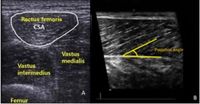A recent study has shed light on how gonarthrosis, or knee osteoarthritis, affects quadriceps muscle architecture and functional capabilities in women. Researchers found that women suffering from this degenerative condition exhibit significant muscle alterations that contribute to fatigue and mobility issues compared to their healthy counterparts.
The comprehensive study analyzed 81 females aged between 47 and 77 years, of whom 40 were diagnosed with gonarthrosis while the remaining 41 participants served as a healthy control group. Using advanced ultrasound imaging techniques, researchers measured key parameters of quadriceps muscle architecture, including thickness and pennation angle of the rectus femoris, vastus intermedius, and vastus lateralis muscles.
Key findings revealed stark contrasts between the two groups. Specifically, the cross-sectional area (CSA) of the quadriceps muscles was significantly lower in the gonarthrosis group, highlighting the effects of muscle atrophy associated with the disease. The right CSA was reduced (p < .001), suggesting that structural changes in the quadriceps may have profound implications for overall physical performance.
In addition to muscle measurements, the study evaluated participants' functional capabilities through various tests such as the Timed Up and Go (TUG) test, 30-second sit-and-up test (SU30s), and the Fatigue Severity Scale (FSS). The results demonstrated that individuals with gonarthrosis experienced longer TUG completion times (p < .001), indicating compromised mobility, while higher FSS scores reflected greater fatigue levels (p < .001).
Notably, the time taken to execute the SU30s was considerably less in the control group, further establishing the adverse impacts of gonarthrosis on physical function (p < .001).
Muscle architecture analysis revealed a significant relationship between functional performance and muscle dimensions. Strong negative correlations were observed between sit-to-stand performance and CSA, suggesting that reductions in muscle size could hamper strength and endurance necessary for daily activities. Conversely, TUG and FSS scores indicated positive correlations with muscle CSA, reinforcing the notion that quadriceps muscle health is vital for maintaining functional mobility.
This research underscores the importance of understanding muscle architecture in the context of knee osteoarthritis. The alterations in quadriceps muscle structure not only contribute to mobility challenges and increased fatigue in patients but also offer potential avenues for targeted therapeutic interventions. By assessing quadriceps morphology through non-invasive ultrasound techniques, clinicians could individualize treatment strategies aimed at preserving muscle integrity and function in individuals affected by gonarthrosis.
Ultimately, this study advocates for a comprehensive approach to managing gonarthrosis, incorporating physical therapy and exercise interventions tailored to improve quadriceps muscle architecture and overall physical performance, thereby enhancing the quality of life for those affected and addressing the significant disability associated with this condition.




